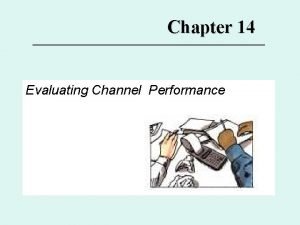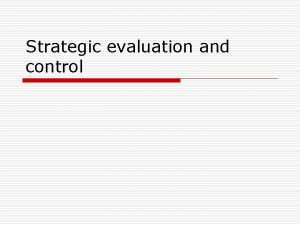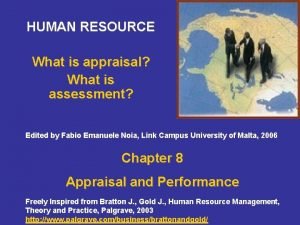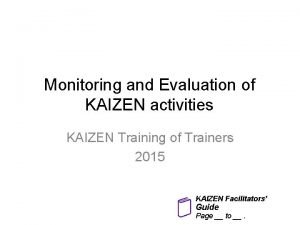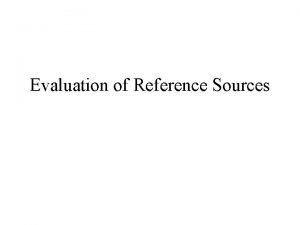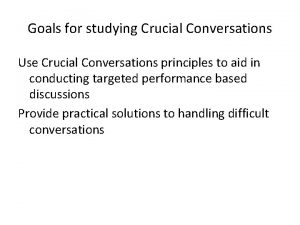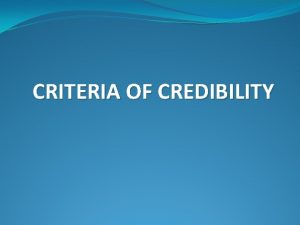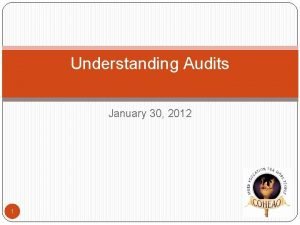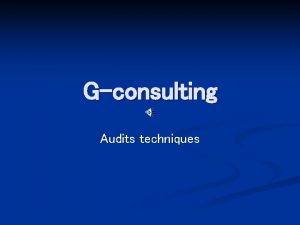STRATEGY EVALUATION CRITERIA PERFORMANCE AUDITS AUDIT Crucial audit






- Slides: 6

STRATEGY EVALUATION CRITERIA: PERFORMANCE AUDITS AUDIT: Crucial audit for assessing and identifying the implementation and performance status of formulated strategies THE FOLLOWING COMPONENTS ARE IMPORTANT: 1. Define the performance measures: • MKTG • Finance • HR Issues 2. 3. 4. 5. Conduct periodic assessment and monitoring Review performance status/ success Identify the critical gaps/ constraints Modify the action plans 1

STRATEGY EVALUATION CRITERIA: PERFORMANCE AUDITS 6. Introduce course corrective measures GOALS TARGETS ACHIEVEMENTS • • CRITICAL GAPS MEASURES TO BE TAKEN Do we need to analyze & predict the environment better realistic Do we need to facilitate strategy implementation as desired 2

STRATEGIC IMPLEMENTAIO PROCESS Evaluate results, assess gaps, and provide feedback Determine strategy and communicate measurable objectives for company as a whole Determine key managerial tasks Assign tasks to various parts of organization, or restructure if necessary Regularly ascertain adequacy of control mechanisms Develop manager talent and educate managers in values and styles of the organization Delegate authority relationships and establish methods for coordination Make provision for a reward system reinforcing desired behavior Allocate resources to SBUs and departments State policies as guides for action Build MIS to provide adequate and timely data useful for business evaluation Clarify goals of various individual managers Operationalize ways to measure performance 3

Benchmarks for Evaluation Overall objectives or assumptions Expected performance at this time Current performance Existing deviations Projected deviations 5% 12% 2% 5% 3% 9% +1% +4% +1% +2% 10 $ 7000 4 $ 6800 2 $ 6900 -2 +$100 -3 +$ 100 Personnel Number of key Managers needed Ratio of indirect cost to direct cost 6 12% 2 14% 3 13% +1 -1% +1 0% R&D Recruitment of senior engineers Increase R & D sales ratio 20 5% 16 4% 10 3% -6 -1% Operations: Increase production capacity 50% 40% 0% 0% Competitor Reactions: Increased R & D Product changes 4% 4 3% 2 4% 3 +1% +1 Key success factors Financial Reduce Overhead Cost Profit on Sales Marketing Analyze new-product Proposals Sales per Employee 4

Strategy Evaluation Criteria Important 1. Are the performance standards too low or too high, or are the environmental assumptions legitimate? If yes, alter by scaling up or down. If no, go to stage 2 2. Is the implementation inadequate? Are policies, resources, or organization changes needed? If yes, alter accordingly if no, go to stage 3 3. Is the strategy inadequate? Has the environment changed unexpected? (Original assumptions are quite uncertain or faulty. ) Is the contingency plan needed? If yes, use the contingency plan or begin to formulate a new strategy. If no, go to stage 4 4. How can we alter our objectives or convince others that the gaps in performance will remain and are acceptable? 5

Audit THE BALANCED SCORE CARD FRAMEWORK Review A balanced set of performance measure for improving financial/ physical performance of firms. Revamp Strategies to fulfill objectives Financial Measures Goals Vs Targets Customer Perspective 1. 2. 3. 4. 5. 6. Quality Packaging Lead Time Response Delivery Schedule Product/ Service Features After Sales Service 1. 2. 3. 4. 5. Turnover Growth GPM - % NPM - % ROI - % Cost Structure Internal Process Re -Engineering 1. 2. 3. 4. New Product New processes Training & Development R & D Initiatives 1. Existing Products 2. Current Business Processes 3. Internal Realignment 4. Other issues Innovation & Learning 6
